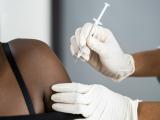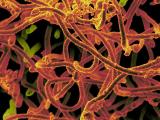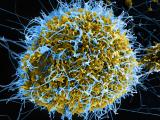The World Health Organization (WHO) today issued guidance on caring for Ebola survivors, emphasizing integrated care for their diverse needs, while two case reports yesterday demonstrated the persistence of Ebola virus in the breast milk and semen of survivors.
The WHO guidance comes after flare-ups of Ebola virus disease (EVD) in West Africa, some tied to sexual transmission of the virus, and after a high-profile relapse in a nurse survivor in the United Kingdom. Issues with survivors include the ability of the Ebola virus to survive for long periods in some parts of the body like the eyes, breasts, and testicles, as well as emotional trauma and long-lasting physical symptoms.
The WHO said there are more than 10,000 Ebola survivors today, the vast majority of them in West Africa.
Guidance covers many facets
The 31-page guidance document includes advice before and after discharge, common lingering conditions (sequelae), monitoring for persistent viral infection, and infection prevention and control. It also has sections on special populations—children and pregnant women—and on risk communication.
The WHO underscores the importance of an integrated approach: "An intensive integrated program is necessary to address the medical and psychosocial needs of EVD survivors as well as the risk of virus reintroduction. Medical services for EVD survivors should ideally be integrated into existing routine health services and facilities."
Pre-discharge care should include education and counseling about potential physical sequelae, including long-term disability and viral persistence, and psychological problems survivors might need to deal with, such as social stigma, the agency says. Close family members should ideally be involved.
The first post-discharge follow-up appointment should include a battery of assessments, such as musculoskeletal, ocular, auditory, neurologic, mental health, and sexual health, the WHO advises. A range of lab tests might also be warranted.
The section on sequelae reflects the largest survivor study yet published, which appeared in The Lancet Infectious Diseases last month. That study, of 227 Sierra Leone Ebola survivors, found that the most common conditions were joint pain (76%), vision problems (60%), hearing difficulties (24%), and eye inflammation (18%). The WHO also details steps to assess and care for other potential sequelae like abdominal pain, neurologic conditions, and relapse due to persistent virus.
This latter possibility was highlighted last fall with the case of UK nurse Pauline Cafferkey. In her case, medical officials said she had meningitis related to her original Ebola infection, and her cerebrospinal fluid tested positive for traces of the virus. The guidance mentions her case without using her name.
The long-lasting effects of Ebola were underscored in a study last month in the New England Journal of Medicine. Of eight US survivors studied, only one had recovered completely at that point.
The section of the WHO guidance on monitoring patients includes details on testing semen, vaginal fluids, and breast milk, as well as advice on counseling survivors about sexual health and breastfeeding.
The agency also emphasizes infection control practices such as proper protective equipment and disposing of infectious waste. The guidance also includes specific steps for patients after handling breast milk or semen that has tested positive for the virus.
In a section on communicating with survivors—called risk communication because it involves messaging during a crisis—the WHO says, "Try to understand how the Ebola survivor and their family perceive their health status and identify their main concerns—stigma, inability to find employment, worries about transmitting the disease through sexual contact or from mother to baby."
It adds, "Elicit these concerns as part of a conversation, before giving advice or instructions. Provide opportunities—prompted or spontaneous—for them to ask questions."
Breastfeeding risk
Both case reports appeared as letters in Emerging Infectious Diseases. In the first letter, an international team details the case of a Guinean woman with 4-month-old twins, who were exclusively breast-fed.
The first twin died after developing a fever and being treated by a traditional healer, and was buried without lab testing. Eleven days after the baby's death, the woman fell ill. She was admitted to an Ebola treatment unit 5 days later and was given convalescent plasma after she tested positive for EVD.
The woman's breast milk tested positive on day 6 of her hospitalization and again on day 14, when she was convalescing, as well as on day 21. On day 24, the woman was given cabergoline to stop her lactation, after which no more breast milk could be collected. Her blood and urine tested negative on day 29. The surviving twin never tested positive for Ebola virus.
The authors conclude, "Considering the high EVD death rate, until further evidence is found, we recommend that EBOV-positive women stop breast-feeding immediately and that breast-feeding not be resumed until 2 negative RT-PCR tests of the breast milk have been confirmed."
Long virus survival in semen
In the second letter, investigators from India describe a 26-year-old Indian man who returned from the outbreak region on Nov 10, 2014, with a certificate from the Liberian government stating he was "cured" of EVD. He was nonetheless placed in isolation at a New Delhi airport, and initial semen samples tested positive for Ebola virus by polymerase chain reaction.
In addition, follow-up semen samples tested positive for 165 days—or more than 5 months—after the patient was declared Ebola-free, but negative after that. The authors note that Ebola virus has been detected in semen for up to 10 months after a patient was declared Ebola-free.
The authors write, "The current elimination period may need to be extended, and further studies on the infectivity of semen samples from recovered EVD patients are warranted."
See also:
Jan 22 WHO guidance
Dec 23, 2015, CIDRAP News story "Ebola studies reveal new findings on survivors, vaccine"
Nov 21, 2015, CIDRAP News story "UK nurse with Ebola meningitis released from isolation"
Dec 17, 2015, CIDRAP News story "Ebola studies highlight survivor symptoms, malaria therapy"
WHO landing page on Ebola survivors
Jan 21 Emerg Infect Dis letter on breastfeeding woman
Jan 21 Emerg Infect Dis letter on male survivor


















